Planting Passions at Simon’s Rock
By Alan Murphy
Every college has popular communal gathering spots — be it a dining hall, student union, or quad. Simon’s Rock goes one better. In late winter and early spring, the greenhouse attached to the Fisher science building acts as a magnet for a cross-section of students, faculty, and staff.
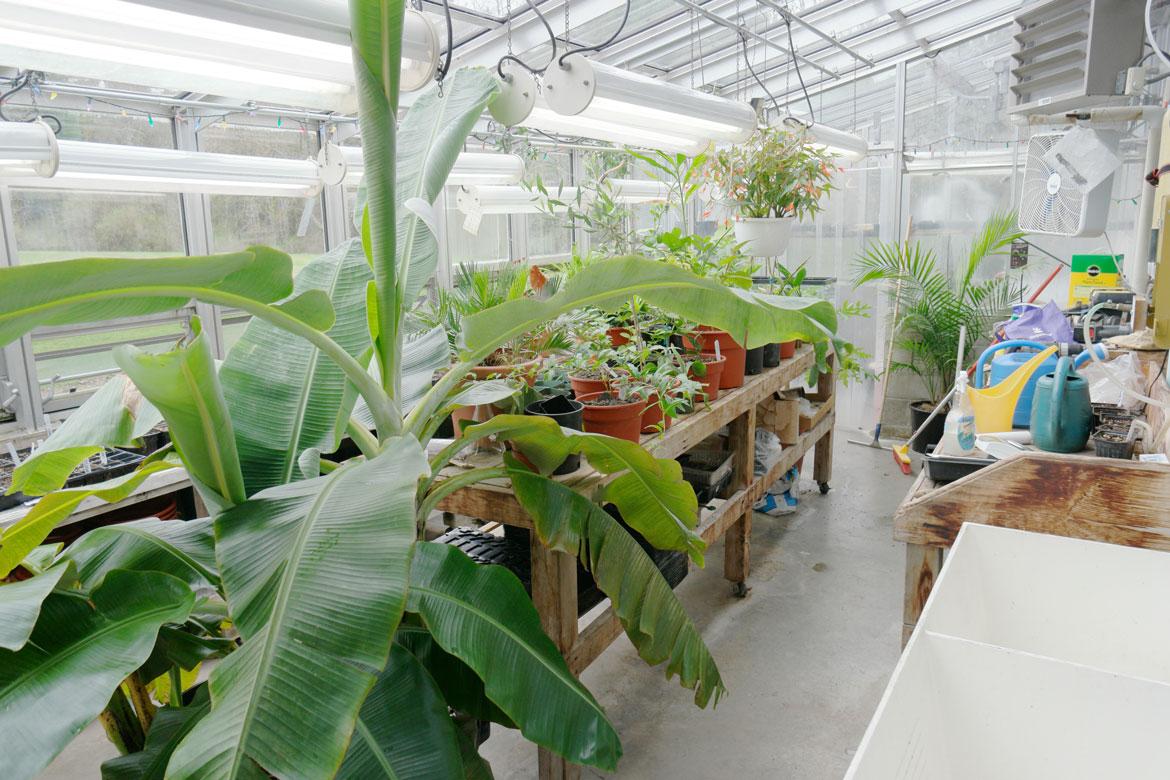
Donald's recently acquired collection is on the center table behind the banana plant. Photo: Alan Murphy
The botanical specimens they come to see are as varied as the visitors themselves. The greenhouse shelves are packed with a diverse array of plants, trays of soil with sprouting seedlings, and botany experiments. One can even spot wildlife, both welcomed (Sarah Snyder’s black-and-white Argentinian tegu and the wintering goldfish awaiting their return to the reflecting pool next to Blodgett) and not (the mouse who nicks seeds from the botany experiments).
The operation is overseen by environmental science assistant professor Donald McClelland ’00, who enjoys introducing students and others to the school’s plant collection. His latest acquisitions come from a spring-break trip to Logee’s, a 125-year-old destination greenhouse in eastern Connecticut that specializes in rare and tropical plants. Many of these newly acquired plants are part of the Solanaceae family, one of Donald's primary areas of research. It spans annuals and perennial herbs, vines, lianas, epiphytes, shrubs, and trees, and includes a number of important agricultural crops, as well as medicinal plants, spices, weeds, and ornamentals. Under Donald’s tutelage, students are conducting experiments pertaining to seed germination and photosynthesis.
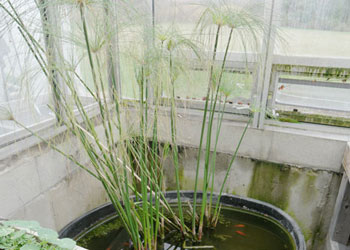
Goldfish in their winter home with a papyrus plant.
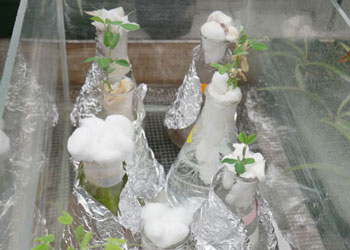
One group of botany experiments.
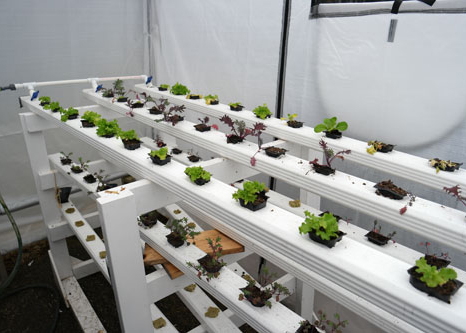
Part of the aquaponics set up inside the hoop house. Tom gets his fish from the Berkshire National Fish Hatchery in Monterey, MA.
Donald’s fellow environmental science faculty, Tom Coote, is also a regular fixture at the greenhouse. He has tray upon tray of vegetable seedlings sprouting in preparation for transplantation in the community garden. Tom can also be spotted in the white-tarped hoop house just a few steps away from the greenhouse. Ask him about the aquaponics operation trickling away inside, and you’ll find yourself getting some detailed and fascinating answers from a sustainability studies expert.
The aquaponics operation has been up and running for a couple of years now and has provided fish for one of the ThinkFOOD conferences. Senior Greig Fields recently completed his thesis on aquaponics—which he considers the future of agriculture. Sophomore Andrew Phennicie lends a hand with the operation, too. Donald and Tom ensure that the environmental studies concentration at Simon’s Rock is sufficiently flexible to accommodate a variety of student interests, whether they relate to aquaponics, ecology, sustainability, or food studies, among others. Tom regularly leads trips to the Caribbean island of Montserrat for additional exploration and learning.
Both instructors eagerly engage students who visit the greenhouse and are willing to share space with all who ask. A Post-it note next to several seedling trays of annuals conveys thanks from the physical plant team for the temporary use of the space. Another note next to some colorful cacti provides instructions for their care over spring break. Alone or in groups, students arrive at all hours to tend to plants and seedlings or to their experiments. There are student workers, too, such as Fiona Ferguson. After a day of toiling in the classrooms of Daniel Art Center, she says she relishes the opportunity to putter about the greenhouse for an hour or two to decompress. Fiona will be spending her junior year in London studying the history of the international art market at Sotheby’s Institute of Art. The way her eyes light up when she’s in the greenhouse suggests she’ll visit many an English garden during her stay.
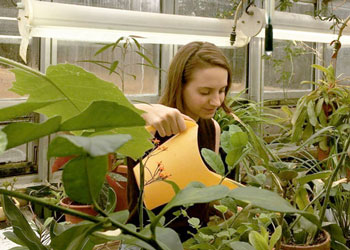
Fiona watering in the greenhouse. Photo courtesy of Micah Doucette.
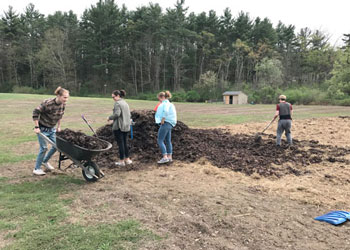
Students prepare the community garden for the seedlings on Earth Day. Photo courtesy of Tom Coote.
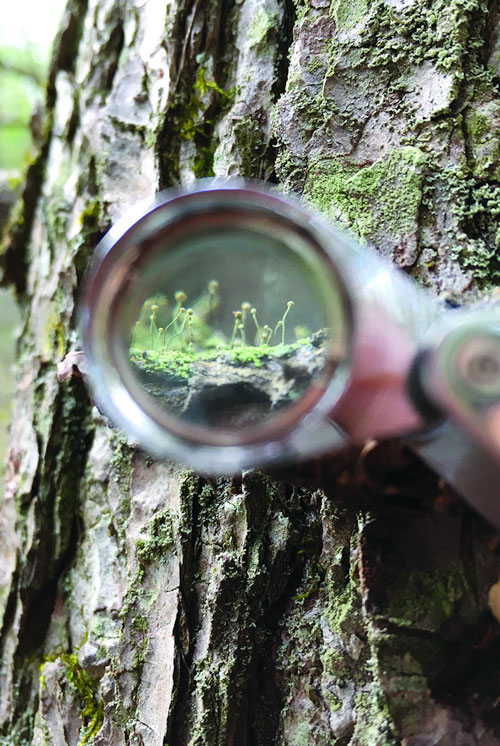
Photo from campus lichen walk (Chaenotheca furfuracea) sponsored by the Cool Sightings book project. Photo courtesy of Sarah Snyder and Li-Mei Lim.
Inevitably, as the spring bulbs start to fade and the warmer weather beckons people outside, so, too, goes the community. A mass of students alighted briefly on the greenhouse only to move onto the community garden down the hill. There, you would recently have found a group of environmental enthusiasts accompanying Donald and fellow researcher Jessica Allen, a recent PhD graduate from the New York Botanical Garden (NYBG) and The City University of New York Graduate Center, touring lichen around the campus. Prior to his return to Simon’s Rock as an instructor, Donald worked in the research department of the NYBG.
Whether it’s in the greenhouse, outside wandering the 275-acre campus, or studying the ecology of a volcanic Caribbean island, there is one certainty: At Simon’s Rock there is a vibrant, ecology-minded community who delight in getting their hands dirty.